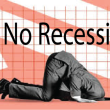by Liz Ann Sonders, Chief Investment Strategist, Kevin Gordon, Charles Schwab & Company Ltd.
Panic is never a good investment strategy—nor is greed. Here's how disciplined investing helps navigate through volatile environments.
Markets do drop. Bear markets arrive. That's an unavoidable part of investing. What matters is how you respond. If you've built a portfolio that is directly tied to your time horizon and risk tolerance when markets are calm, then a surge in turbulence may not leave you shaken. Good planning, and discipline along the way, is like a pre-emptive dose of Dramamine—it can help neutralize some of the nausea before the turbulence hits.
Panic and greed
Greed can also lead us astray in a number of ways. First, there's the temptation to load up on aggressive higher-risk assets in the hope of a big payoff. But there is a dark side to an aggressive posture's potential higher returns: the risk taken in getting there. Aggressive portfolios' higher historical returns have had a much wider range of returns—that is, a higher standard deviation, with greater "drawdowns," or peak-to-trough declines, and volatility. And most importantly, those higher returns typically are generated through "stick-to-it-iveness," not lucky bets.
Then there's the temptation to try to "time" markets. It's enticing to try to catch the next big investment wave (up or down) and allocate assets accordingly. But there are very few time-tested tools for consistently making those decisions well.
It's also important to consider how the two impulses can work together, with yesterday's greed paving the way to tomorrow's panic. Investors may think they understand their risk tolerance—until they don't. There's a big difference between financial risk tolerance (the ability to financially withstand volatile markets) and emotional risk tolerance. The gap between the two is often quite wide and typically becomes evident in tumultuous market environments.
Relying on the rearview mirror
Many aggressive investors have learned the hard way that they had a lower tolerance for a big loss in the short term than they thought. And to maintain their aggressive allocations via rebalancing, they generally had to double down on the asset classes that generated those steep losses and shift away from the asset classes that had weathered the storm.
Conservative investors should heed the lesson, as well. A conservative portfolio's lower historical returns have come with significantly less-severe drawdowns and volatility. For some, the lower return is worth the sleep-at-night benefits. But the reality is that many investors want all of the upside when markets are performing well, but none of the downside when they are not. That is highly unrealistic.
Rebalancing
It may be challenging to sell investments that have done well and add to holdings that have underperformed, but developing and maintaining the right long-term asset mix is by far the most important set of decisions an investor will ever make. Rebalancing forces us to do what we know we're supposed to do, which is "buy low, sell high" (perhaps better thought of as "add low, trim high" from a rebalancing perspective). Importantly, the absence of a rebalancing strategy can get otherwise-disciplined portfolios out-of-whack.
The chart below shows two periods and illustrates the peril of not rebalancing, using a very simplistic moderate portfolio allocation of 60% equities and 40% bonds (60-40). For the 10 years beginning in 2009, an investor who did no rebalancing would have experienced equity exposure growing from 60% to nearly 85%. That would have left the investor overly exposed to equities just ahead of the COVID-related bear market as 2020 unfolded.
The right side of the chart covers the period specifically associated with the COVID bear market. Assuming the starting point at the end of 2019 was at the standard 60% equities and 40% bonds and no rebalancing was done during the short-lived bear market, the investor would have lost some recovery potential once the market bottomed.
Annual rebalancing can add needed discipline

Source: Schwab Center for Financial Research with data from Morningstar, Inc.
Source: Schwab Center for Financial Research with data from Morningstar, Inc. The portfolio above is composed of 60% stocks and 40% bonds on 2/28/2009, and is not rebalanced through 12/31/2019. It is rebalanced to 60% stocks and 40% bonds on 12/31/2019 and not rebalanced through 3/31/2020. Hypothetical asset class allocations are derived from a weighted average of the total monthly returns of indices representing each asset class. The indices representing the hypothetical asset classes are the S&P 500 Index (stocks) and the Bloomberg US Aggregate Bond Index (bonds). Returns assume reinvestment of dividends and interest. Indexes are unmanaged, do not incur management fees, costs, and expenses, and cannot be invested in directly. Rebalancing does not protect against losses or guarantee that an investor's goal will be met. Rebalancing may cause investors to incur transaction costs and, when a non-retirement account is rebalanced, taxable events may be created that may affect your tax liability. The example is hypothetical and provided for illustrative purposes only. It is not intended to represent a specific investment product. Dividends and interest are assumed to have been reinvested, and the example does not reflect the effects of taxes or fees. Past performance is no guarantee of future results.
The closest thing to a "free lunch"
Admittedly, the development of a long-term strategic asset allocation plan isn't the hard part—it's sticking to it that often becomes the real challenge. That can be especially difficult when markets are volatile. But if we learn from our mistakes, use our brains over our hearts and look to our portfolios as rebalancing guides, we can expect a more successful investing future and maybe even get a free lunch along the way.
Copyright © Charles Schwab & Company Ltd.














